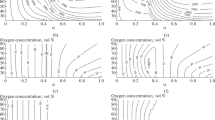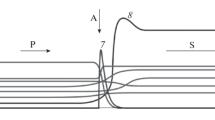Abstract
The influence of the formation of microheterogeneous soot particles on the gas-phase conversion of rich mixtures of methane with oxygen into synthesis gas in a temperature range from 1500 to 1800 K under the conditions of an adiabatic reactor was studied by kinetic modeling. The effect of CO2 and H2O additives on this process was studied. The appearance of soot particles was observed in rich mixtures, starting from the fuel excess factor ϕ = 3.33. At relatively low temperatures of ~1500 K, a small amount of microheterogeneous soot particles was formed, which did not significantly affect other components of the reacting system. A noticeable effect of soot particles at this temperature was observed at a higher value of ϕ = 8.0. This was most clearly manifested in the temperature profile of the process, in which two maximums were observed at times of about 0.01 and 0.1 s upon the addition of water to the reacting mixture. In the case of CO2 additions, the second maximum in the temperature profile was almost not pronounced. A complex temperature profile led to the appearance of the second concentration maximum of hydroxyl radicals OH at times of ~0.1 s. The addition of H2O and CO2 made it possible to vary the H2/CO ratio in the synthesis gas over a wide range, which is necessary for the synthesis of various products. Because the added CO2 under these conditions was actually involved in the chemical process of obtaining synthesis gas, its partial recirculation from the conversion products made it possible to reduce its emission in the production of synthesis gas.














Similar content being viewed by others
REFERENCES
Arutyunov, V.S., Golubeva, I.A., Eliseev, O.L., and Zhagfarov, F.G., Tekhnologiya pererabotki uglevodorodnykh gazov. Uchebnik dlya vuzov (Hydrocarbon Gas Processing Technology. Textbook for Universities), Moscow: Yurait, 2020.
Arutyunov, V.S., Hydrogen energy: Significance, sources, problems, prospects (a review), Pet. Chem., 2022, vol. 62, no. 4, p. 583. https://doi.org/10.1134/S0965544122040065
Nikitin, A., Ozersky, A., Savchenko, V., Sedov, I., Shmelev, V., Arutyunov, V., Matrix conversion of natural gas to syngas: The main parameters of the process and possible applications, Chem. Eng. J., 2019, vol. 377, p. 120883. https://doi.org/10.1016/j.cej.2019.01.162
Aldoshin, S.M., Arutyunov, V.S., Savchenko, V.I., Sedov, I.V., Nikitin, A.V., and Fokin, I.G., Physical methods for studying chemical reactions: New non-catalytic methods for processing hydrocarbon gases, Russ. J. Phys. Chem. B, 2021, vol. 14, no. 5, p. 46. https://doi.org/10.1134/S1990793121030039
Savchenko, V.I., Zimin, Ya.S., Nikitin, A.V., Sedov, I.V., and Arutyunov, V.S., Utilization of CO2 in non-catalytic dry reforming of C1–C4 hydrocarbons, J. CO 2 Util., 2021, vol. 47, p. 101490. https://doi.org/10.1016/j.jcou.2021.101490
Savchenko, V.I., Nikitin, A.V., Zimin, Ya.S., Ozerskii, A.V., Sedov, I.V., and Arutyunov, V.S., Impact of post-flame processes on the hydrogen yield in matrix partial oxidation reformer, Chem. Eng. Res. Des., 2021, vol. 175, p. 250. https://doi.org/10.1016/j.cherd.2021.09.009
Savchenko, V.I., Zimin, Ya.S., Buzillo, E., Nikitin, A.V., Sedov, I.V., and Arutyunov, V.S., Equilibrium composition of products formed by non-catalytic conversion of hydrocarbons, Pet. Chem., 2022, vol. 62, no. 3, p. 375. https://doi.org/10.1134/S0965544122050048
Agafonov, G.L., Bilera, I.V., Vlasov, P.A., Kolbanovskii, Yu.A., Smirnov, V.N., and Tereza, A.M., Soot formation during the pyrolysis and oxidation of acetylene and ethylene in shock waves, Kinet. Catal., 2015, vol. 56, no. 1, p. 15. https://doi.org/10.7868/S0453881115010013
Akhun’yanov, A.R., Arutyunov, A.V., Vlasov, P.A., Smirnov, V.N., and Arutyunov, V.S., Effect of CO2 additives on the non-catalytic conversion of natural gas into synthesis gas and hydrogen, Kinet. Katal., 2023, vol. 64, no. 2, p. 153. https://doi.org/10.31857/S0453881123020016
Frenklach, M., Computer modeling of infinite reactions sequences: A chemical lumping, Chem. Eng. Sci., 1985, vol. 40, p. 1843.
Frenklach, M., Taki, S., and Matula, R.A., A conceptual model for soot formation in pyrolysis of aromatic hydrocarbons, Combust. Flame, 1983, vol. 49, p. 275.
Appel, J., Bockhorn, H., and Frenklach, M., Kinetic modeling of soot formation with detailed chemistry and physics: Laminar premixed flames of C2 hydrocarbons, Combust. Flame, 2000, vol. 121, nos. 1–2, p. 122.
Wang, H. and Frenklach, M., A detailed kinetic modeling study of aromatics formation in laminar premixed acetylene and ethylene flames, Combust. Flame, 1997, vol. 110, nos. 1–2, p. 173.
Frenklach, M. and Wang, H., Detailed mechanism and modeling of soot particle formation, in Soot Formation in Combustion: Mechanisms and Models, Bockhorn, H., Ed., Springer Series In Chemical Physics, Berlin: Springer, 1994, vol. 59, p. 162.
Richter, H., Granata, S., Green, W.H., and Howard, J.B., Detailed modeling of PAH and soot formation in a laminar premixed benzene/oxygen/argon low-pressure flame, Proc. Combust. Inst., 2005, vol. 30, no. 1, p. 1397.
Deuflhard, P. and Wulkow, M., Computational treatment of polyreaction kinetics by orthogonal polynomials of a discrete variable, Impact Comput. Sci. Eng., 1989, vol. 1, p. 269.
Wulkow, M., The simulation of molecular weight distribution in polyreaction kinetics by discrete Galerkin methods, Macromol. Theory Simul., 1996, vol. 5, p. 393.
Wang, H., You, X., Joshi, A.V., Davis, S.G., Laskin, A., Egolfopoulos, F., and Law, C.K., USC Mech Version II. High temperature combustion reaction model of H2/CO/C1–C4 compounds. http://ignis.usc.edu/USC-MechII.htm.
Agafonov, G.L., Bilera, I.V., Vlasov, P.A., Zhil’tsova, I.V., Kolbanovskii, Yu.A., Smirnov, V.N., and Tereza, A.M., Unified kinetic model of soot formation in the pyrolysis and oxidation of aliphatic and aromatic hydrocarbons in shock waves, Kinet. Catal., 2016, vol. 57, no. 5, p. 557.
Skjoth-Rasmussen, M.S., Glarborg, P., Ostberg, M., Johannessen, J.T., Livbjerg, H., Jensen, A.D., and Christensen, T.S., Formation of polycyclic aromatic hydrocarbons and soot in fuel-rich oxidation of methane in a laminar flow reactor, Combust. Flame, 2004, vol. 136, p. 91.
Richter, H., Granata, S., Green, W.H., and Howard, J.B., Detailed modeling of PAH and soot formation in a laminar premixed benzene/oxygen/argon low-pressure flame, Proc. Combust. Inst., 2005, vol. 30, p. 1397.
Frenklach, M. and Warnatz, J., Detailed modeling of PAH profiles in a sooting low-pressure acetylene flame, Combust. Sci. Technol., 1987, vol. 51, p. 265.
Wang, H., Dames, E., Sirjean, B., Sheen, D.A., Tangko, R., Violi, A., A high-temperature chemical kinetic model of n-alkane (up to n-dodecane), cyclohexane, and methyl-, ethyl-, n-propyl and n-butyl-cyclohexane oxidation at high temperatures. JetSurF Version 2.0, 2010. http://web.stanford.edu/group/haiwanglab/JetSurF/JetSurF2.0/index.htm.
Correa, C., Niemann, H., Schramm, B., and Warnatz, J., Reaction mechanism reduction for higher hydrocarbons by the ILDM method, Proc. Combust. Inst., 2000, vol. 28, p. 1607.
Hansen, N., Klippenstein, S.J., Westmoreland, P.R., Kasper, T., Kohse-Hoinghaus, K., Wang, J., and Cool, T.A., A combined ab initio and photoionization mass spectrometric study of polyynes in fuel-rich flames, Phys. Chem. Chem. Phys., 2008, vol. 10, p. 366.
Agafonov, G.L., Mikhailov, D.I., Smirnov, V.N., Tereza, A.M., Vlasov, P.A., and Zhiltsova, I.V., Shock tube and modeling study of chemical ionization in the oxidation of acetylene and methane mixtures, Combust. Sci. Technol., 2016, vol. 188, nos. 11–12, p. 1815. https://doi.org/10.1080/00102202.2016.1211861
Vlasov, P.A., Zhiltsova, I.V., Smirnov, V.N., Tereza, A.M., Agafonov, G.L., and Mikhailov, D.I., Chemical ionization of n-hexane, acetylene, and methane behind reflected shock waves, Combust. Sci. Technol., 2018, vol. 190, no. 1, p. 57. https://doi.org/10.1080/00102202.2017.1374954
Vlasov, P.A., Akhun’yanov, A.R., and Smirnov, V.N., Experimental studies and simulation of methane pyrolysis and oxidation in reflected shock waves accompanied by soot formation, Kinet. Catal., 2022, vol. 63, no. 2, p. 141. https://doi.org/10.1134/S0023158422020124
Agafonov, G.L., Borisov, A.A., Smirnov, V.N., Troshin, K.Ya., Vlasov, P.A., and Warnatz, J., Soot formation during pyrolysis of methane and rich methane/oxygen mixtures behind reflected shock waves, Combust. Sci. Technol., 2008, vol. 180, no. 10, p. 1876. https://doi.org/10.1080/00102200802261423
Agafonov, G.L., Smirnov, V.N., and Vlasov, P.A., A shock-tube and modeling study of soot formation during pyrolysis of propane, propane/toluene and rich propane/oxygen mixtures, Combust. Sci. Technol., 2010, vol. 182, no. 11, p. 1645. https://doi.org/10.1080/00102202.2010.497331
Agafonov, G.L., Naydenova, I., Vlasov, P.A., and Warnatz, J., Detailed kinetic modeling of soot formation in shock tube pyrolysis and oxidation of toluene and n-heptane, Proc. Combust. Inst., 2007, vol. 31, p. 575. https://doi.org/10.1016/j.proci.2006.07.191
Naydenova, I., Nullmeier, M., Warnatz, J., and Vlasov, R.A., Detailed kinetic modeling of soot formation during shock-tube pyrolysis of C6H6: Direct comparison with the results of time-resolved laser-induced incandescence (LII) and CW-laser extinction measurements, Combust. Sci. Technol., 2004, vol. 176, p. 1667. https://doi.org/10.1080/00102200490487544
Vlasov, P.A., Agafonov, G.L., Mikhailov, D.I., Smirnov, V.N., Tereza, A.M., Zhiltsova, I.V., Sychev, A.E., Shchukin, A.S., Khmelenin, D.N., Streletskii, A.N., Borunova, A.B., and Stovbun, S.V., Shock-tube study of the formation of iron, carbon, and iron-carbon binary nanoparticles: Experiment and detailed kinetic simulations, Combust. Sci. Technol., 2019, vol. 191, no. 2, p. 243. https://doi.org/10.1080/00102202.2018.1451995
Vlasov, P.A. and Warnatz, J., Detailed kinetic modeling of soot formation in hydrocarbon pyrolysis behind shock waves, Proc. Combust. Inst., 2002, vol. 29, p. 2335.
Agafonov, G.L., Smirnov, V.N., and Vlasov, P.A., Shock tube and modeling study of soot formation during the pyrolysis and oxidation of a number of aliphatic and aromatic hydrocarbons, Proc. Combust. Inst., 2011, vol. 33, p. 625. https://doi.org/10.1016/j.proci.2010.07.089
Vlasov, P.A. and Varnatts, Yu., Kinetic modeling of soot formation during pyrolysis of various aliphatic and aromatic hydrocarbons in shock waves, Khim. Fiz., 2004, vol. 23, no. 10, p. 42.
Vlasov, P.A., Varnatts, Yu., and Naidenova, I., Modeling of the kinetic mechanism of soot formation during the oxidation of rich mixtures of n-heptane, methane and propane in shock waves, Khim. Fiz., 2004, vol. 23, no. 11, p. 36.
Vlasov, P.A., Smirnov, V.N., Tereza, A.M., Agafonov, G.L., Kolbanovskii, Yu.A., Bilera, I.V., Mikhailov, D.I., and Zhil’tsova, I.V., Effect of pressure on soot formation in the pyrolysis of n-hexane and the oxidation of fuel-rich mixtures of n-heptane behind reflected shock waves, Russ. J. Phys. Chem. B, 2016, vol. 10, no. 12, p. 912. https://doi.org/10.1134/S1990793116060282
Agafonov, G.L., Bilera, I.V., Vlasov, P.A., Kolbanovskii, Yu.A., Smirnov, V.N., and Tereza, A.M., Formation of soot particles in pyrolysis and oxidation of aliphatic and aromatic hydrocarbons: Experiments and detailed kinetic modeling, Russ. J. Phys. Chem. B, 2016, vol. 10, no. 8, p. 587. https://doi.org/10.1134/S1990793116040199
Agafonov, G.L., Vlasov, P.A., and Smirnov, V.N., Soot formation in the pyrolysis of benzene, methylbenzene, and ethylbenzene in shock waves, Kinet. Catal., 2011, vol. 52, no. 3, p. 358.
Agafonov, G.L., Smirnov, V.N., and Vlasov, P.A., Effect of iron pentacarbonyl on soot formation behind shock waves, Combust. Sci. Technol., 2012, vol. 184, nos. 10–11, p. 1838. https://doi.org/10.1080/00102202.2012.690644
Funding
This study was carried out at the Semenov Federal Research Center for Chemical Physics, Russian Academy of Sciences and supported by the Russian Science Foundation (grant no. 22-73-00171).
Author information
Authors and Affiliations
Corresponding author
Ethics declarations
The authors declare that they have no conflicts of interest.
Additional information
Translated by V. Makhlyarchuk
Rights and permissions
About this article
Cite this article
Akhunyanov, A.R., Vlasov, P.A., Smirnov, V.N. et al. Influence of Soot Particles on the Gas-Phase Methane Conversion into Synthesis Gas: The Role of H2O and CO2 Additives. Kinet Catal 64, 700–715 (2023). https://doi.org/10.1134/S0023158423060010
Received:
Revised:
Accepted:
Published:
Issue Date:
DOI: https://doi.org/10.1134/S0023158423060010




